Home >> Waves, polarization of light
explanation |
||
Explanation
Light waves are transverse waves, where 'particles' of the wave oscillate in a line at right angles to the direction of travel.

In a light beam there are many waves with lines of oscillation set at random angles.
Polarization is the production of waves oscillating in one plane (ie with one line of oscillation) from a source of randomly oscillating waves.
In this work it is convenient to represent light waves in a simplified form. Only the vertical and horizontal waves are represented when explaining the various phenomena around polarization.

note: A light wave is actually two waves, in phase and oriented at 90o to each other. One wave is E, the electric field vector and the other is B, the magnetic field vector.
When interacting with matter, the E wave is much more important than the B wave. So for simplicity the B wave is ignored.

Polaroid
Polaroid* is a material, usually plastic, which allows light to pass but only where the wave oscillates in ONE particular orientation. This orientation is called the reference direction.
Consider a single piece of Polaroid where the reference direction is vertical. When a beam of unpolarized light is directed at the Polaroid, a beam of vertically polarized light rays is transmitted.
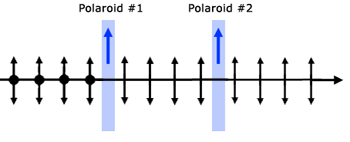
If a second piece of Polaroid similar to the first is placed infront of the polarized beam the beam will be transmitted with only a very small loss in intensity.
However, if the second Polaroid is rotated through 90o no light is transmitted. An observer looking in this way at a bright light would see the light reduce in brightness as the Polaroid is rotated until the image disappears completely in darkness.
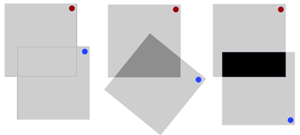
*Polaroid is a trade name. Polaroid is actually a sandwich of sheets of nitrocellulose. The nitrocellulose is seeded with crystals of quinine iodosulphate, which have the property of aligning their axes in one particular direction. This property (dichroism) screens out all light except that with the same orientation.
Reflection
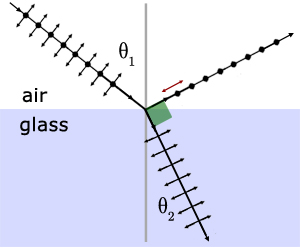
θ1 is the angle of incidence
θ2 is the angle of refraction
μ is the refractive index (air- glass)
Applying Snell's Law,
 (i
(i
but θ1 and θ2 are complementary (they add up to 90o ),
therefore, ![]()
substituting for θ2 into equation (i
 (ii
(ii
but ![]()
substituting for sin(90o - θ1) into equation (ii

![]()
In other words, the angle of incidence has a tangent value equal to the refractive index.
The relationship is called Brewster's Law.
The angle of incidence is also called the polarizing angle or the angle of polarization .
Double Refraction
Double refraction is the property particular crystals(eg calcilte) have that allows them to split an unpolarized ray into two rays that are plane polarized at right angles to each other.
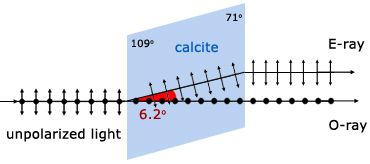
In this particular orientation of the crystal, the Ordinary (O) ray has normal incidence, while the Extraordinary (E) ray follows a path as if it had an angle of refraction in the calcite of 6.2o
Stress analysis & mineralogy uses
Polarized light for stress analysis and looking at minerals is used in the same manner. In each case the specimen is illuminated with polarized light from one side and then observed through Polaroid from the other.
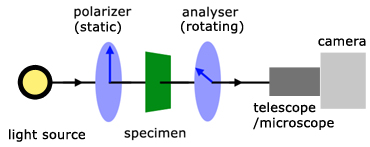
Stress analysis is important in the design and manufacture of parts for industry. Replicas in clear plastic are put under stress to highlight weaknesses in molded shapes. The images produced illustrate the photo-elastic behaviour of the plastic.

Polarization is also used in mineralogy to identify the crystalline components of different rocks.

The different colours are a result of double refraction or as it is sometimes called, birefringence.
The strength of double refraction in crystals dictates the range and depth of colours produced. The colours themselves are as a result of interference between rays.
[ About ] [ FAQ ] [ Links ] [ Terms & Conditions ] [ Privacy ] [ Site Map ] [ Contact ]
